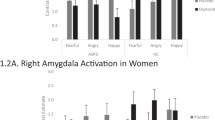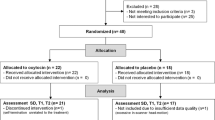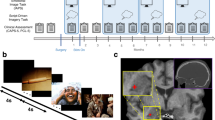Abstract
Post-traumatic stress disorder (PTSD) is a disabling psychiatric disorder. As a substantial part of PTSD patients responds poorly to currently available psychotherapies, pharmacological interventions boosting treatment response are needed. Because of its anxiolytic and pro-social properties, the neuropeptide oxytocin (OT) has been proposed as promising strategy for treatment augmentation in PTSD. As a first step to investigate the therapeutic potential of OT in PTSD, we conducted a double-blind, placebo-controlled, cross-over functional MRI study examining OT administration effects (40 IU) on amygdala reactivity toward emotional faces in unmedicated male and female police officers with (n=37, 21 males) and without (n=40, 20 males) PTSD. Trauma-exposed controls were matched to PTSD patients based on age, sex, years of service and educational level. Under placebo, the expected valence-dependent amygdala reactivity (ie, greater activity toward fearful-angry faces compared with happy-neutral faces) was absent in PTSD patients. OT administration dampened amygdala reactivity toward all emotional faces in male and female PTSD patients, but enhanced amygdala reactivity in healthy male and female trauma-exposed controls, independent of sex and stimulus valence. In PTSD patients, greater anxiety prior to scanning and amygdala reactivity during the placebo session were associated with greater reduction of amygdala reactivity after OT administration. Taken together, our results indicate presumably beneficial neurobiological effects of OT administration in male and female PTSD patients. Future studies should investigate OT administration in clinical settings to fully appreciate its therapeutic potential.
Similar content being viewed by others
Log in or create a free account to read this content
Gain free access to this article, as well as selected content from this journal and more on nature.com
or
References
Acheson D, Feifel D, de Wilde S, McKinney R, Lohr J, Risbrough V (2013). The effect of intranasal oxytocin treatment on conditioned fear extinction and recall in a healthy human sample. Psychopharmacology (Berl) 229: 199–208.
American Psychiatric Association (2013) DSM-V, Diagnostic and Statistical Manual of Mental Disorders. American Psychiatric Publishing Inc.: Arlington, VA, USA.
Bartz JA, Simeon D, Hamilton H, Kim S, Crystal S, Braun A et al (2011). Oxytocin can hinder trust and cooperation in borderline personality disorder. Soc Cogn Affect Neurosci 6: 556–563.
Bartz JA, Zaki J, Ochsner KN, Bolger N, Kolevzon A, Ludwig N et al (2010). Effects of oxytocin on recollections of maternal care and closeness. Proc Natl Acad Sci USA 107: 21371–21375.
Bertsch K, Gamer M, Schmidt B, Schmidinger I, Walther S, Kästel T et al (2013). Oxytocin and reduction of social threat hypersensitivity in women with borderline personality disorder. Am J Psychiatry 170: 1169–1177.
Blake DD, Weathers FW, Nagy LM, Kaloupek DG, Gusman FD, Charney DS et al (1995). The development of a Clinician-Administered PTSD Scale. J Trauma Stress 8: 75–90.
Bradley R, Ph D, Greene J, Russ E, Dutra L, Westen D et al (2005). Reviews and overviews a multidimensional meta-analysis of psychotherapy for PTSD. Am J Psychiatry 214–227.
Bremner JD, Bolus R, Mayer EA (2007). Psychometric properties of the early trauma inventory-self report. J Nerv Ment Dis 195: 211–218.
Brunetti M, Sepede G, Mingoia G, Catani C, Ferretti A, Merla A et al (2010). Elevated response of human amygdala to neutral stimuli in mild post traumatic stress disorder: neural correlates of generalized emotional response. Neuroscience 168: 670–679.
Bryant RA, Felmingham K, Kemp A, Das P, Hughes G, Peduto A et al (2008). Amygdala and ventral anterior cingulate activation predicts treatment response to cognitive behaviour therapy for post-traumatic stress disorder. Psychol Med 38: 555–561.
Buchheim A, Heinrichs M, George C, Pokorny D, Koops E, Henningsen P et al (2009). Oxytocin enhances the experience of attachment security. Psychoneuroendocrinology 34: 1417–1422.
Cardoso C, Ellenbogen MA, Orlando MA, Bacon SL, Joober R (2013). Intranasal oxytocin attenuates the cortisol response to physical stress: a dose-response study. Psychoneuroendocrinology 38: 399–407.
Carlier I, Gersons B (1992). Development of a scale for traumatic incidents in police work. Psychiatr Fenn 23: 59–70.
de Kleine RA, Rothbaum BO, van Minnen A (2013). Pharmacological enhancement of exposure-based treatment in PTSD: a qualitative review. Eur J Psychotraumatol 4.
de Oliveira DCG, Zuardi AW, Graeff FG, Queiroz RHC, Crippa JAS (2012). Anxiolytic-like effect of oxytocin in the simulated public speaking test. J Psychopharmacol 26: 497–504.
de Vries G, Olff M (2009). The lifetime prevalence of traumatic events and posttraumatic stress disorder in the Netherlands. J Trauma Stress 22: 259–267.
Diener MJ, Monroe JM (2011). The relationship between adult attachment style and therapeutic alliance in individual psychotherapy: a meta-analytic review. Psychotherapy (Chic) 48: 237–248.
Dodhia S, Hosanagar A, Fitzgerald DA, Labuschagne I, Wood AG, Nathan PJ et al (2014). Modulation of resting-state amygdala-frontal functional connectivity by oxytocin in generalized social anxiety disorder. Neuropsychopharmacology 39: 2061–2069.
Domes G, Heinrichs M, Gläscher J, Büchel C, Braus DF, Herpertz SC (2007). Oxytocin attenuates amygdala responses to emotional faces regardless of valence. Biol Psychiatry 62: 1187–1190.
Domes G, Heinrichs M, Kumbier E, Grossmann A, Hauenstein K, Herpertz SC (2013). Effects of intranasal oxytocin on the neural basis of face processing in autism spectrum disorder. Biol Psychiatry 74: 164–171.
Domes G, Kumbier E, Heinrichs M, Herpertz SC (2014). Oxytocin promotes facial emotion recognition and amygdala reactivity in adults with asperger syndrome. Neuropsychopharmacology 39: 698–706.
Domes G, Lischke A, Berger C, Grossmann A, Hauenstein K, Heinrichs M et al (2010). Effects of intranasal oxytocin on emotional face processing in women. Psychoneuroendocrinology 35: 83–93.
Dunlop BW, Mansson E, Gerardi M (2012). Pharmacological innovations for posttraumatic stress disorder and medication-enhanced psychotherapy. Curr Pharm Des 18: 5645–5658.
Felmingham K, Williams LM, Kemp AH, Liddell B, Falconer E, Peduto A et al (2010). Neural responses to masked fear faces: sex differences and trauma exposure in posttraumatic stress disorder. J Abnorm Psychol 119: 241–247.
First MB, Spitzer RL, Gibbon M, Williams JB (2012) Structured Clinical Interview for DSM-IV Axis I Disorders (SCID-I), Clinician Version, Administration Booklet. American Psychiatric Publishing Inc.: Arlington, VA.
Foa EB, Keane TM, Friedman MJ, Cohen JA (2009) Effective Treatments for PTSD: Practice Guidelines from the International Society of Traumatic Stress Studies. Guilford Press: New York, NY, USA.
Frijling JL, van Zuiden M, Nawijn L, Koch SBJ, Neumann ID, Veltman DJ et al (2015). Salivary oxytocin and vasopressin levels in police officers with and without post-traumatic stress disorder. J Neuroendocrinol 27: 743–751.
Gamer M, Zurowski B, Büchel C (2010). Different amygdala subregions mediate valence-related and attentional effects of oxytocin in humans. Proc Natl Acad Sci USA 107: 9400–9405.
Gläscher J, Adolphs R (2003). Processing of the arousal of subliminal and supraliminal emotional stimuli by the human amygdala. J Neurosci 23: 10274–10282.
Groppe SE, Gossen A, Rademacher L, Hahn A, Westphal L, Gründer G et al (2013). Oxytocin influences processing of socially relevant cues in the ventral tegmental area of the human brain. Biol Psychiatry 74: 172–179.
Hariri AR, Tessitore A, Mattay VS, Fera F, Weinberger DR (2002). The amygdala response to emotional stimuli: a comparison of faces and scenes. Neuroimage 17: 317–323.
Hayes AF (2013) Introduction to Mediation, Moderation and Conditional Process Analysis. Guilford Press: New York, NY, USA.
Hayes JP, Hayes SM, Mikedis AM (2012). Quantitative meta-analysis of neural activity in posttraumatic stress disorder. Biol Mood Anxiety Disord 2: 9.
Heinrichs M, Baumgartner T, Kirschbaum C, Ehlert U (2003). Social support and oxytocin interact to suppress cortisol and subjective responses to psychosocial stress. Biol Psychiatry 54: 1389–1398.
Huber D, Veinante P, Stoop R (2005). Vasopressin and oxytocin excite distinct neuronal populations in the central amygdala. Science 308: 245–248.
Kirsch P, Esslinger C, Chen Q, Mier D, Lis S, Siddhanti S et al (2005). Oxytocin modulates neural circuitry for social cognition and fear in humans. J Neurosci 25: 11489–11493.
Koch SBJ, van Zuiden M, Nawijn L, Frijling JL, Veltman DJ, Olff M (2014). Intranasal oxytocin as strategy for medication-enhanced psychotherapy of PTSD: salience processing and fear inhibition processes. Psychoneuroendocrinology 40: 242–256.
Labuschagne I, Phan KL, Wood A, Angstadt M, Chua P, Heinrichs M et al (2010). Oxytocin attenuates amygdala reactivity to fear in generalized social anxiety disorder. Neuropsychopharmacology 35: 2403–2413.
Lischke A, Gamer M, Berger C, Grossmann A, Hauenstein K, Heinrichs M et al (2012). Oxytocin increases amygdala reactivity to threatening scenes in females. Psychoneuroendocrinology 37: 1431–1438.
Milad MR, Pitman RK, Ellis CB, Gold AL, Shin LM, Lasko NB et al (2009). Neurobiological basis of failure to recall extinction memory in posttraumatic stress disorder. Biol Psychiatry 66: 1075–1082.
Morris JS, Frith CD, Perrett DI, Rowland D, Young AW, Calder AJ et al (1996). A differential neural response in the human amygdala to fearful and happy facial expressions. Nature 383: 812–815.
Olff M (2012). Bonding after trauma: on the role of social support and the oxytocin system in traumatic stress. Eur J Psychotraumatol 3: 1–11.
Olff M, Frijling JL, Kubzansky LD, Bradley B, Ellenbogen MA, Cardoso C et al (2013). The role of oxytocin in social bonding, stress regulation and mental health: an update on the moderating effects of context and interindividual differences. Psychoneuroendocrinology 38: 1883–1894.
Olff M, Langeland W, Witteveen A, Denys D (2010). A psychobiological rationale for oxytocin in the treatment of posttraumatic stress disorder. CNS Spectr 15: 522–530.
Ormhaug SM, Jensen TK, Wentzel-Larsen T, Shirk SR (2014). The therapeutic alliance in treatment of traumatized youths: relation to outcome in a randomized clinical trial. J Consult Clin Psychol 82: 52–64.
Paloyelis Y, Doyle OM, Zelaya FO, Maltezos S, Williams SC, Fotopoulou A et al (2014). A spatiotemporal profile of in vivo cerebral blood flow changes following intranasal oxytocin in humans. Biol Psychiatry doi:10.1016/j.biopsych.2014.10.005).
Patel R, Spreng RN, Shin LMF, Girard TA (2012). Neurocircuitry models of posttraumatic stress disorder and beyond: a meta-analysis of functional neuroimaging studies. Neurosci Biobehav Rev 36: 2130–2142.
Petrovic P, Kalisch R, Singer T, Dolan RJ (2008). Oxytocin attenuates affective evaluations of conditioned faces and amygdala activity. J Neurosci 28: 6607–6615.
Pitman RK, Rasmusson AM, Koenen KC, Shin LM, Orr SP, Gilbertson MW et al (2012). Biological studies of post-traumatic stress disorder. Nat Rev Neurosci 13: 769–787.
Preckel K, Scheele D, Kendrick KM, Maier W, Hurlemann R (2014). Oxytocin facilitates social approach behavior in women. Front Behav Neurosci 8: 191.
Rauch SL, Shin LM, Phelps EA (2006). Neurocircuitry models of posttraumatic stress disorder and extinction: human neuroimaging research—past, present, and future. Biol Psychiatry 60: 376–382.
Rilling JK, Demarco AC, Hackett PD, Chen X, Gautam P, Stair S et al (2014). Sex differences in the neural and behavioral response to intranasal oxytocin and vasopressin during human social interaction. Psychoneuroendocrinology 39: 237–248.
Rothbaum BO, Davis M (2003). Applying learning principles to the treatment of post-trauma reactions. Ann N Y Acad Sci 1008: 112–121.
Seeley WW, Menon V, Schatzberg AF, Keller J, Glover GH, Kenna H et al (2007). Dissociable intrinsic connectivity networks for salience processing and executive control. J Neurosci 27: 2349–2356.
Sheehan DV, Lecrubier Y, Sheehan KH, Amorim P, Janavs J, Weiller E et al (1998). The Mini-International Neuropsychiatric Interview (M.I.N.I.): the development and validation of a structured diagnostic psychiatric interview for DSM-IV and ICD-10. J Clin Psychiatry 59: 22–33; quiz 34–57.
Spielberger C (1983) Manual for the State-Trait Anxiety Inventory (form Y). Consulting Psychologists Press: Palo Alto, CA, USA.
Sripada CS, Phan KL, Labuschagne I, Welsh R, Nathan PJ, Wood AG (2013). Oxytocin enhances resting-state connectivity between amygdala and medial frontal cortex. Int J Neuropsychopharmacol 16: 255–260.
Sripada RK, King AP, Garfinkel SN, Wang X, Sripada CS, Welsh RC et al (2012). Altered resting-state amygdala functional connectivity in men with posttraumatic stress disorder. J Psychiatry Neurosci 37: 241–249.
Striepens N, Matusch A, Kendrick KM, Mihov Y, Elmenhorst D, Becker B et al (2014). Oxytocin enhances attractiveness of unfamiliar female faces independent of the dopamine reward system. Psychoneuroendocrinology 39: 74–87.
van Groenestijn M, Akkerhuis G, Kupka R, Schneider N, Nolen W (1999) Gestructureerd Klinisch Interview voor de vaststelling van DSM-IV As 1 Stoornissen [Dutch translation of the SCID-I/P]. Zwets & Zeitlinger: Lisse, the Netherlands.
Van IJzendoorn MH, Bakermans-Kranenburg MJ (2012). A sniff of trust: meta-analysis of the effects of intranasal oxytocin administration on face recognition, trust to in-group, and trust to out-group. Psychoneuroendocrinology 37: 438–443.
van Rooij SJH, Kennis M, Vink M, Geuze E (2015). Predicting treatment outcome in PTSD: a longitudinal functional MRI study on trauma-unrelated emotional processing. Neuropsychopharmacology (doi:10.1038/npp.2015.257).
van Rooij SJH, Rademaker AR, Kennis M, Vink M, Kahn RS, Geuze E (2014). Neural correlates of trauma-unrelated emotional processing in war veterans with PTSD. Psychol Med 45: 575–587.
van Vliet I, Leroy H, van Megen H (2000). MINI Plus: MINI Internationaal Neuropsychiatrisch Interview: Dutch Version 5.0. LUMC.
Weisman O, Feldman R (2013). Oxytocin effects on the human brain: findings, questions, and future directions. Biol Psychiatry 74: 158–159.
Woodhouse S, Ayers S, Field AP (2015) The relationship between adult attachment style and post-traumatic stress symptoms: a meta-analysis. J Anxiety Disord 35: 103–117.
Zoicas I, Slattery DA, Neumann ID (2014). Brain oxytocin in social fear conditioning and its extinction: involvement of the lateral septum. Neuropsychopharmacology 39: 3027–3035.
Acknowledgements
The authors thank Gré Westerveld, Renée Hutter, Marthe Hoofwijk and all other personnel of the Arq PDC police outpatient clinic for their valuable help with recruitment of the PTSD patients. Registered in the Netherlands Trial Registry (number: NTR3516) (http://www.trialregister.nl/trialreg/admin/rctview.asp?TC=3516).
Author information
Authors and Affiliations
Corresponding author
Additional information
Supplementary Information accompanies the paper on the Neuropsychopharmacology website
Supplementary information
Rights and permissions
About this article
Cite this article
Koch, S., van Zuiden, M., Nawijn, L. et al. Intranasal Oxytocin Administration Dampens Amygdala Reactivity towards Emotional Faces in Male and Female PTSD Patients. Neuropsychopharmacol 41, 1495–1504 (2016). https://doi.org/10.1038/npp.2015.299
Received:
Revised:
Accepted:
Published:
Issue date:
DOI: https://doi.org/10.1038/npp.2015.299
This article is cited by
-
Oxytocin effects on amygdala reactivity to angry faces in males and females with antisocial personality disorder
Neuropsychopharmacology (2023)
-
Oxytocin vs. placebo effects on intrusive memory consolidation using a trauma film paradigm: a randomized, controlled experimental study in healthy women
Translational Psychiatry (2023)
-
The effect of oxytocin, gender, and ovarian hormones on stress reactivity in individuals with cocaine use disorder
Psychopharmacology (2020)
-
The oxytocinergic system in PTSD following traumatic childbirth: endogenous and exogenous oxytocin in the peripartum period
Archives of Women's Mental Health (2020)
-
Genetic variant in CACNA1C is associated with PTSD in traumatized police officers
European Journal of Human Genetics (2018)



